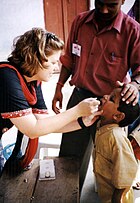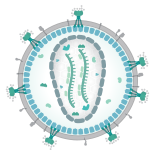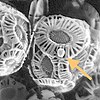Portal:Viruses
The Viruses Portal
Welcome!

Viruses are small infectious agents that can replicate only inside the living cells of an organism. Viruses infect all forms of life, including animals, plants, fungi, bacteria and archaea. They are found in almost every ecosystem on Earth and are the most abundant type of biological entity, with millions of different types, although only about 6,000 viruses have been described in detail. Some viruses cause disease in humans, and others are responsible for economically important diseases of livestock and crops.
Virus particles (known as virions) consist of genetic material, which can be either DNA or RNA, wrapped in a protein coat called the capsid; some viruses also have an outer lipid envelope. The capsid can take simple helical or icosahedral forms, or more complex structures. The average virus is about 1/100 the size of the average bacterium, and most are too small to be seen directly with an optical microscope.
The origins of viruses are unclear: some may have evolved from plasmids, others from bacteria. Viruses are sometimes considered to be a life form, because they carry genetic material, reproduce and evolve through natural selection. However they lack key characteristics (such as cell structure) that are generally considered necessary to count as life. Because they possess some but not all such qualities, viruses have been described as "organisms at the edge of life".
Selected disease

Meningitis is an acute inflammation of the meninges, protective membranes covering the brain and spinal cord. Symptoms in adults include headache, fever and neck stiffness, as well as sometimes confusion or altered consciousness, vomiting, and an inability to tolerate light or loud noises. Children often show only nonspecific symptoms, such as irritability or drowsiness.
The most common cause is infection with viruses including enteroviruses, herpes simplex virus (mainly HSV-2), varicella zoster virus, mumps virus, HIV and lymphocytic choriomeningitis. In Western countries, viral meningitis occurs in around 11 people per 100,000 each year. Infection with bacteria, fungi, protozoa and parasites can also cause meningitis, and there are several non-infectious causes. Although some forms of meningitis can be life-threatening, viral meningitis is generally more benign than that caused by bacterial infection. It usually resolves spontaneously and is rarely fatal. HSV-2 can cause a chronic, recurrent form called Mollaret's meningitis.
Polymerase chain reaction of cerebrospinal fluid and identification of antibodies can be used to differentiate between viral causes. Viral meningitis typically only requires supportive therapy; meningitis caused by HSV or varicella zoster virus sometimes responds to treatment with antiviral drugs such as aciclovir. Mumps-associated meningitis can be prevented by vaccination.
Selected image
1802 cartoon of Edward Jenner administering cowpox vaccine against smallpox, satirising contemporary fears about vaccination.
Credit: James Gillray (12 June 1802)
In the news
26 February: In the ongoing pandemic of severe acute respiratory syndrome coronavirus 2 (SARS-CoV-2), more than 110 million confirmed cases, including 2.5 million deaths, have been documented globally since the outbreak began in December 2019. WHO
18 February: Seven asymptomatic cases of avian influenza A subtype H5N8, the first documented H5N8 cases in humans, are reported in Astrakhan Oblast, Russia, after more than 100,0000 hens died on a poultry farm in December. WHO
14 February: Seven cases of Ebola virus disease are reported in Gouécké, south-east Guinea. WHO
7 February: A case of Ebola virus disease is detected in North Kivu Province of the Democratic Republic of the Congo. WHO
4 February: An outbreak of Rift Valley fever is ongoing in Kenya, with 32 human cases, including 11 deaths, since the outbreak started in November. WHO
21 November: The US Food and Drug Administration (FDA) gives emergency-use authorisation to casirivimab/imdevimab, a combination monoclonal antibody (mAb) therapy for non-hospitalised people twelve years and over with mild-to-moderate COVID-19, after granting emergency-use authorisation to the single mAb bamlanivimab earlier in the month. FDA 1, 2
18 November: The outbreak of Ebola virus disease in Équateur Province, Democratic Republic of the Congo, which started in June, has been declared over; a total of 130 cases were recorded, with 55 deaths. UN
Selected article
Vaccination or immunisation is the administration of immunogenic material (a vaccine) to stimulate an individual's immune system to develop adaptive immunity to a virus or other pathogen, and so develop protection against an infectious disease. The active agent of a vaccine may be intact but inactivated or weakened forms of the pathogen, or purified highly immunogenic components, such as viral envelope proteins. Smallpox was the first disease for which a vaccine was produced, by Edward Jenner in 1796.
Vaccination is the most effective method of preventing infectious diseases and can also ameliorate the symptoms of infection. When a sufficiently high proportion of a population has been vaccinated, herd immunity results. Widespread immunity due to mass vaccination is largely responsible for the worldwide eradication of smallpox and the elimination of diseases such as polio from much of the world. Since their inception, vaccination efforts have met with objections on scientific, ethical, political, medical safety and religious grounds, and the World Health Organization considers vaccine hesitancy an important threat to global health.
Selected outbreak
The 2009 flu pandemic was an influenza pandemic first recognised in Mexico City in March 2009 and declared over in August 2010. It involved a novel strain of H1N1 influenza virus with genes from five different viruses, which resulted when a previous triple reassortment of avian, swine and human influenza viruses further combined with a Eurasian swine influenza virus, leading to the term "swine flu" being used for the pandemic. It was the second pandemic to involve an H1N1 strain, the first being the 1918 "Spanish flu" pandemic.
The global infection rate was estimated as 11–21%. This pandemic strain was less lethal than previous ones, killing about 0.01–0.03% of those infected, compared with 2–3% for Spanish flu. Most experts agree that at least 284,500 people died, mainly in Africa and Southeast Asia – comparable with the normal seasonal influenza fatalities of 290,000–650,000 – leading to claims that the World Health Organization had exaggerated the danger.
Selected quotation
| “ | A virus is a piece of bad news wrapped in protein. | ” |
Recommended articles
Viruses & Subviral agents: bat virome • elephant endotheliotropic herpesvirus • HIV • introduction to viruses![]() • Playa de Oro virus • poliovirus • prion • rotavirus
• Playa de Oro virus • poliovirus • prion • rotavirus![]() • virus
• virus![]()
Diseases: colony collapse disorder • common cold • croup • dengue fever![]() • gastroenteritis • Guillain–Barré syndrome • hepatitis B • hepatitis C • hepatitis E • herpes simplex • HIV/AIDS • influenza
• gastroenteritis • Guillain–Barré syndrome • hepatitis B • hepatitis C • hepatitis E • herpes simplex • HIV/AIDS • influenza![]() • meningitis
• meningitis![]() • myxomatosis • polio
• myxomatosis • polio![]() • pneumonia • shingles • smallpox
• pneumonia • shingles • smallpox
Epidemiology & Interventions: 2007 Bernard Matthews H5N1 outbreak • Coalition for Epidemic Preparedness Innovations • Disease X • 2009 flu pandemic • HIV/AIDS in Malawi • polio vaccine • Spanish flu • West African Ebola virus epidemic
Virus–Host interactions: antibody • host • immune system![]() • parasitism • RNA interference
• parasitism • RNA interference![]()
Methodology: metagenomics
Social & Media: And the Band Played On • Contagion • "Flu Season" • Frank's Cock![]() • Race Against Time: Searching for Hope in AIDS-Ravaged Africa
• Race Against Time: Searching for Hope in AIDS-Ravaged Africa![]() • social history of viruses
• social history of viruses![]() • "Steve Burdick" • "The Time Is Now" • "What Lies Below"
• "Steve Burdick" • "The Time Is Now" • "What Lies Below"
People: Brownie Mary • Macfarlane Burnet![]() • Bobbi Campbell • Aniru Conteh • people with hepatitis C
• Bobbi Campbell • Aniru Conteh • people with hepatitis C![]() • HIV-positive people
• HIV-positive people![]() • Bette Korber • Henrietta Lacks • Linda Laubenstein • Barbara McClintock
• Bette Korber • Henrietta Lacks • Linda Laubenstein • Barbara McClintock![]() • poliomyelitis survivors
• poliomyelitis survivors![]() • Joseph Sonnabend • Eli Todd • Ryan White
• Joseph Sonnabend • Eli Todd • Ryan White![]()
Selected virus
Human immunodeficiency virus (HIV) is a lentivirus, an RNA virus in the retrovirus family. Two types of HIV have been characterised: HIV-1 is the more virulent and is responsible for most infections worldwide; HIV-2 is mainly confined to West Africa. The genome consists of two copies of a single-stranded +RNA, which contains nine genes. The roughly spherical virus particle has a diameter of about 120 nm; it is enveloped and contains a conical capsid made of around 2,000 copies of the p24 protein. The envelope glycoprotein, a trimeric complex of gp120 and gp41, binds to CD4, the primary receptor on the host cell.
Transmission occurs by the transfer of bodily fluids including blood, semen, vaginal fluids and breast milk, in which the virus is present both as free virus particles and within infected immune cells. HIV infects key cells in the human immune system including CD4+ T helper cells, macrophages and dendritic cells. Infection leads to low levels of CD4+ T cells via several mechanisms, resulting in a progressive immunodeficiency disease known as AIDS.
Did you know?
- ...that coccolithovirus (pictured, arrow), a giant double-stranded DNA virus, has 472 protein-coding genes, and was the largest known marine virus by genome until the 2013 discovery of Pandoravirus salinus?
- ...that Tony Minson developed a new way of disabling viruses for vaccines?
- ...that the Oscar Award-nominated film The Final Inch, a documentary about efforts to eradicate the poliovirus, is the first film project from Google's philanthropic division Google.org?
- ...that a June 5, 1981, report by Joel Weisman in MMWR about five gay men with an unusual illness is recognized as the start of the AIDS pandemic and "the first report on AIDS in the medical literature"?
- ...that elastomeric respirators are used not only to protect against COVID-19 and tear gas, but also as fashion items?
Selected biography
Ryan Wayne White (6 December 1971 – 8 April 1990) was an HIV-positive American teenager who became a national spokesman for AIDS research and public education about HIV/AIDS, after being expelled from school because of his infection.
White, a haemophiliac, was diagnosed in 1984 after infection by a contaminated blood treatment. HIV/AIDS was then poorly understood, and his return to school in Kokomo, Indiana was prevented by protesters; the ensuing legal battle gained national media coverage. Before his case, AIDS was widely associated with the male gay community; White was one of several who helped to shift that perception.
White died in 1990, one month before his high school graduation. Shortly afterwards, the U.S. Congress passed a major piece of AIDS legislation, the Ryan White Care Act. Ryan White Programs remain the largest provider of services for people living with HIV/AIDS in the United States.
In this month
1 April 1911: Peyton Rous showed that a cell-free isolate could transmit sarcoma in chickens, an early demonstration of cancer caused by a virus
7 April 1931: First electron micrograph taken by Ernst Ruska and Max Knoll
8 April 1976: Bacteriophage MS2 (pictured) sequenced by Walter Fiers and coworkers, first viral genome to be completely sequenced
8 April 1990: Death from AIDS of Ryan White, haemophiliac teenager for whom the Ryan White Care Act is named
8 April 1992: Tennis player Arthur Ashe announced that he had been infected with HIV from blood transfusions
9 April 1982: Stanley Prusiner proposed proteinaceous prions as the cause of scrapie
12 April 1955: Success of trial of Jonas Salk's polio vaccine announced
12 April 2013: New order of double-stranded DNA bacteriophages, Ligamenvirales, announced
15 April 1957: André Lwoff proposes a concise definition of a virus
21 April 1989: Discovery of hepatitis C virus by Qui-Lim Choo and colleagues
28 April 1932: First yellow fever vaccine announced at an American Societies for Experimental Biology meeting by Wilbur Sawyer
29 April 2015: PAHO and WHO declared the Americas region free from rubella transmission
30 April 1937: Discovery of Theiler's murine encephalomyelitis virus, later a model for multiple sclerosis research
Selected intervention
| “ | the most damaging medical hoax of the last 100 years —Dennis Flaherty, 2011 |
” |
The MMR vaccine and autism fraud refers to the false claim that the combined vaccine for measles, mumps and rubella (MMR) might be associated with colitis and autism spectrum disorders. Multiple large epidemiological studies have since found no link between the vaccine and autism. The notion originated in a fraudulent research paper by Andrew Wakefield and co-authors, published in the prestigious medical journal The Lancet in 1998. Sunday Times journalist Brian Deer's investigations revealed that Wakefield had manipulated evidence and had multiple undeclared conflicts of interest. The paper was retracted in 2010, when the Lancet's editor-in-chief Richard Horton characterised it as "utterly false". Wakefield was found guilty of serious professional misconduct by the General Medical Council, and struck off the UK's Medical Register. The claims in Wakefield's article were widely reported in the press, resulting in a sharp drop in vaccination uptake in the UK and Ireland. A greatly increased incidence of measles and mumps followed, leading to deaths and serious permanent injuries.
Subcategories
Subcategories of virology:
Topics
Things to do
- Comment on what you like and dislike about this portal
- Join the Viruses WikiProject
- Tag articles on viruses and virology with the project banner by adding {{WikiProject Viruses}} to the talk page
- Assess unassessed articles against the project standards
- Create requested pages: red-linked viruses | red-linked virus genera
- Expand a virus stub into a full article, adding images, citations, references and taxoboxes, following the project guidelines
- Create a new article (or expand an old one 5-fold) and nominate it for the main page Did You Know? section
- Improve a B-class article and nominate it for Good Article
 or Featured Article
or Featured Article status
status - Suggest articles, pictures, interesting facts, events and news to be featured here on the portal
WikiProjects & Portals
 WikiProject Viruses
Related WikiProjects
WikiProject Viruses
Related WikiProjects
Medicine • Microbiology • Molecular & Cellular Biology • Veterinary Medicine
Related PortalsAssociated Wikimedia
The following Wikimedia Foundation sister projects provide more on this subject:
-
Commons
Free media repository -
Wikibooks
Free textbooks and manuals -
Wikidata
Free knowledge base -
Wikinews
Free-content news -
Wikiquote
Collection of quotations -
Wikisource
Free-content library -
Wikispecies
Directory of species -
Wikiversity
Free learning tools -
Wiktionary
Dictionary and thesaurus

















